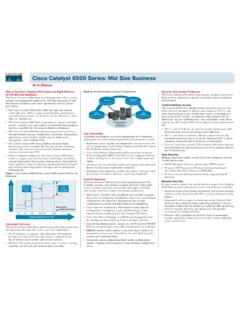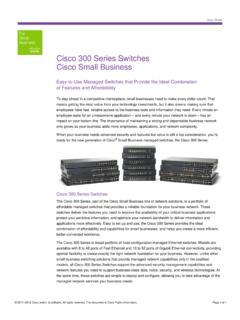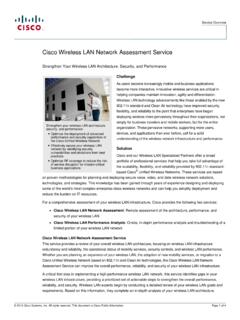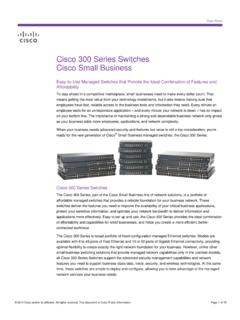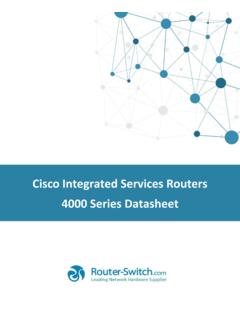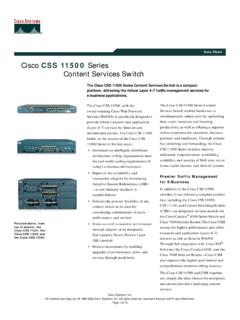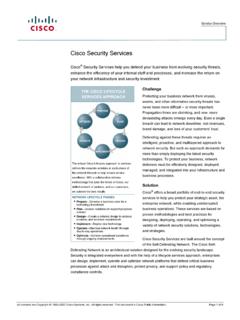Transcription of Cisco Wireless LAN Controllers - Mobile ID Solutions
1 All contents are Copyright 1992 2006 Cisco Systems, Inc. All rights reserved. Important Notices and Privacy Statement. Page 1 of 16 Data Sheet Cisco Wireless LAN Controllers Figure 1. Cisco 2000 Series and 4400 Series Wireless LAN Controllers Figure 2. Integrated Controllers 2006 Cisco Systems, Inc. All rights reserved. Important notices, privacy statements, and trademarks of Cisco Systems, Inc. can be found on Page 2 of 17 PRODUCT OVERVIEW Cisco Wireless LAN Controllers are ideal for small, mid-sized, enterprise business and service provider Wireless LAN deployments and provide system-wide Wireless LAN functions, such as security policies, intrusion prevention, RF management, quality of service (QoS), and mobility. They work in conjunction with Cisco lightweight access points and Cisco Wireless Control System (WCS) Software to support business - critical Wireless applications. From voice and guest access services to location tracking, WLAN Controllers provide the control, scalability, and reliability that IT managers need to build secure, enterprise-scale Wireless networks from branch offices to outdoor campuses.
2 Cisco Wireless LAN Controllers smoothly integrate into existing enterprise and service provider networks. They communicate with Cisco lightweight access points over any Layer 2 (Ethernet) or Layer 3 (IP) infrastructure using the Lightweight Access Point Protocol (LWAPP) (Figure 3). This emerging IETF standard helps ensure that communication between access points and Wireless LAN Controllers remains secure, and it enables important Wireless LAN configuration and management functions to be completely automated for cost-effective Wireless LAN operations. Figure 3. Centralized Wireless LAN Cisco Wireless LAN Controllers enable enterprises to create and enforce policies for an end-to-end Wireless LAN system that supports business critical applications. Multiple WLAN Controllers automatically discover each other and seamlessly coordinate WLAN services across themselves. In this way, Cisco Wireless LAN Controllers work together as a single, seamless system to deliver a scalable WLAN network with thousands of APs.
3 From voice and data services to location tracking, Cisco Wireless LAN Controllers provide the control, scalability, and reliability that IT managers need to build secure, large-scale Wireless networks. Flexible Deployment Options Cisco Systems offers several Wireless LAN Controllers that address different enterprise deployment scenarios. These include the Cisco 2000 Series, 4400 Series, Catalyst 6500 Wireless services Module (WiSM), Wireless LAN Controller Module for Integrated Service Routers (ISR) and the Catalyst 3750G Integrated Wireless LAN Controller. The Cisco 2000 Series delivers Cisco s award-winning Wireless LAN services to small and medium-sized enterprise environments. It supports up to six lightweight access points, making it a cost-effective solution for smaller buildings. With integrated Dynamic Host Control Protocol (DHCP) 2006 Cisco Systems, Inc. All rights reserved. Important notices, privacy statements, and trademarks of Cisco Systems, Inc. can be found on Page 3 of 17 services and zero-touch access point configuration, the Cisco 2000 Series is also ideal for environments with limited onsite IT support, such as branch offices within a distributed enterprise.
4 The Cisco 4400 Series Wireless LAN Controller is designed for medium to large size facilities and is available in two models the 4402 with two Gigabit Ethernet ports comes in configurations that support 12, 25, and 50 access points, and the 4404 with four Gigabit Ethernet ports supports 100 access points. The 4402 provides one expansion slot and the 4404 provides two expansion slots that can be used to add VPN termination today, as well as enhanced functionality in the future. In addition, each 4400 WLAN Controller supports an optional redundant power supply to ensure maximum availability. Wireless LAN Controllers are also available for the Cisco Catalyst 6500 and Integrated services Routers. For more information on Cisco Catalyst 6500 (WiSM), visit For more information on Cisco Integrated Service Routers (WLCM), visit For more information on the Cisco Catalyst 3750G Integrated Wireless LAN Controller visit 2006 Cisco Systems, Inc. All rights reserved. Important notices, privacy statements, and trademarks of Cisco Systems, Inc.
5 Can be found on Page 4 of 17 Intelligent RF Management All Cisco WLAN Controllers come equipped with embedded software for adaptive real-time RF management. The Cisco WLAN system uses patent pending Radio Resource Management (RRM) algorithms that detect and adapt to changes in the air space in real-time. These adjustments create the optimal topology for Wireless networking in much the same way that routing protocols compute the best possible topology for IP networks. Figure 4. Network Wide RF Intelligence 2006 Cisco Systems, Inc. All rights reserved. Important notices, privacy statements, and trademarks of Cisco Systems, Inc. can be found on Page 5 of 17 Specific intelligent RF capabilities managed by Cisco Wireless LAN Controllers include: Dynamic channel assignment channels are adjusted to optimize network coverage and performance based on changing RF conditions. Interference detection and avoidance The system detects interference and recalibrates the network to avoid performance problems.
6 Load balancing The system provides automatic load balancing of users across multiple access points for optimum network performance, even under heavy load. Coverage hole detection and correction Radio Resource Management (RMM) software detects coverage holes and attempts to correct them by adjusting the power output of access points. Dynamic power control The system dynamically adjusts the power output of individual access points to accommodate changing network conditions, helping to ensure predictable Wireless performance and availability Airtight Security Cisco Wireless LAN Controllers adhere to the strictest level of security standards, including: Wi-Fi Protected Access 2 (WPA2), WPA, and Wired Equivalent Privacy (WEP) with multiple Extensible Authentication Protocol (EAP) types Protected EAP (PEAP), EAP with Transport Layer Security (EAP-TLS), EAP with Tunneled TLS (EAP-TTLS), EAP-FAST, EAP-SIM and Cisco LEAP VPN termination optional module for the 4400 Series that provides IP Security (IPSec) VPN termination Management Frame Protection Federal Information Processing Standards (FIPS) 140-2 Level 2 Validation The result is the industry s most comprehensive Wireless LAN security solution.
7 In the Cisco Wireless LAN architecture, access points act as air monitors, communicating real-time information about the Wireless domain to Wireless LAN Controllers . All security threats are rapidly identified and presented to network administrators via Cisco WCS, where accurate analysis can take place and corrective action can be taken. Cisco provides the only Wireless LAN system that offers simultaneous Wireless protection and Wireless LAN service delivery. This helps to ensure complete Wireless LAN protection, with no unnecessary overlay equipment costs or extra monitoring devices. The Cisco Wireless LAN system can be deployed initially as a standalone Wireless intrusion prevention system, and reconfigured later to add Wireless LAN data service. This allows network managers to create a defense shield around their RF domains, containing unauthorized Wireless activity until they are ready to deploy Wireless LAN services . Cisco addresses Wireless LAN security by offering multiple layers of protection, including: RF security Detect and avoid interference and control unwanted RF propagation Wireless LAN intrusion prevention, location and correlation The Cisco Wireless LAN system not only detects rogue devices or potential Wireless threats, but also locates these devices.
8 This enables system administrators to quickly assess the threat level and take immediate action to mitigate threats as required. The IDS signature engine on Controllers and on the Cisco WCS automatically eliminates duplicate alerts for rogue access points, rogue clients, and IDS signatures that previously occurred when two or more access points detected the same attacker. Now instead of one IDS alert from each detecting access point, a single alert is generated for the attack. Identity-based networking IT staff must support many different user access rights, device formats, and application requirements when securing Wireless LANs. The Cisco Wireless LAN system enables enterprises to deliver individualized security policies to Wireless users or groups of users. These include: Layer 2 security (PEAP, TLS, TTLS, FAST, SIM, LEAP), WPA, (WPA2) Layer 3 security (and above) IPSec, web authentication VLAN assignments Access control lists (ACLs) IP restrictions, protocol types, port, and differentiated services code point (DSCP) value 2006 Cisco Systems, Inc.
9 All rights reserved. Important notices, privacy statements, and trademarks of Cisco Systems, Inc. can be found on Page 6 of 17 QoS multiple service levels, bandwidth contracts, traffic shaping and RF utilization Authentication, Authorization, and Accounting (AAA)/RADIUS User session policies and rights management Management Frame Protection - Management frame protection (MFP) provides for the authentication of management frames by the Wireless network infrastructure. This allows the network to detect spoofed frames from access points or malicious users impersonating infrastructure access points. Network Admission Control (NAC) Enforce policies pertaining to client configuration and behavior, to ensure that only end-user devices with appropriate security utilities can gain access to the network. Secure mobility Maintain the highest level of security in Mobile environments. This includes VPNs that follow users as they move, eliminating the need to re-establish secure tunnels.
10 In addition, Cisco has developed Proactive Key Caching (PKC), an extension to the standard and precursor to the standard that facilitates secure roaming with AES encryption and RADIUS authentication. Guest tunneling Provides additional security for access to the corporate network by guest users. It ensures that guest users are unable to access the corporate network without first passing through the corporate firewall. Secure backhaul Encrypts data traffic over Wireless backhaul links for additional security. Figure 5. Multiple Layers of Wireless LAN Protection Real-Time Application Support The Cisco Wireless LAN system provides best-in-class performance to support real-time applications such as voice. Cisco Wireless LAN Controllers enable rapid handoff between access points and multiple Controllers , providing smooth mobility with no interruption in service to the client. Intelligent queuing and contention management schemes provide effective resource management of the air space.
